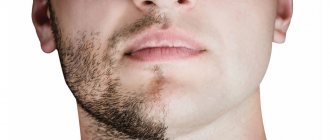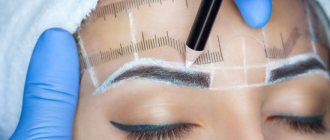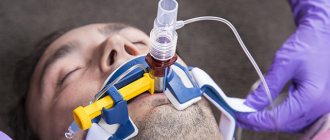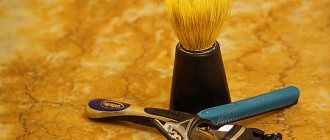Alas, not every guy can grow a thick beard by simply stopping shaving. For some, stubble grows unevenly on their cheeks, or even completely - due to genetics or other reasons, there is practically no facial hair.
- Travel bag 5 reasons why you can’t grow a beard (is it fixable?) Why does this happen?
But even in this case, it is not necessary to say goodbye to the dream of becoming a bearded man forever. One way that can help is hair transplantation. We will tell you more about this operation in this material.
Features and indications of the procedure
According to reports from the Society for Hair Restoration Surgery, about 70 thousand men underwent transplantation in a year. The transplantation process itself is not complicated, but requires certain knowledge in the field of facial anatomy and physiological characteristics of the body.
First, the man is examined, tests are taken and a series of studies are carried out to make sure there are no contraindications. The operation is performed if there is partial or complete absence of hair on the lower part of the face, under the lip and where the sideburns are located.
The transplanted bulbs take root well, thanks to which the man has the opportunity to grow a beard and mustache of the required thickness and length throughout his life.
There are the following indications for performing a surgical procedure:
- Lack of hair where the beard grows.
- The presence of scars on the face, due to which the hair follicles are damaged.
- Skin injuries and appearance defects.
If the listed indications exist, the doctor examines the patient, selects a transplant option and sets a date for the operation.
Hair transplant: indications and methods
Despite the active development of medicine and specifically surgery in the 21st century, there are not so many plastic clinics where high-quality hair transplants are performed. Moreover, transplanting hair onto a beard is much more difficult than performing a standard operation on the scalp. After all, previously everyone used the STRIP method, which involves transplanting a large flap of skin: in the case of facial hair transplantation, this is simply unacceptable.
To transplant hair follicles onto a beard, you need to use more gentle, minimally invasive methods. These have already been developed and are actively used in practice. Of course, in terms of cost, such a hair transplant is significantly inferior to the conservative method, but in terms of quality it is significantly superior to it. These innovative methods include:
- FUT method;
- FUE method;
- HFE method.
Beard hair transplant
How to determine which method is needed in a particular case? The patient should not think about this - only the doctor should decide this issue. As for the indications for this procedure, there may be several. But first of all, desire, because not every man needs a thick beard to be happy if it is naturally light or facial hair does not grow at all. It’s another matter when there is no beard partly due to damage to the skin, or if the hair on it looks sloppy or completely ugly.
Transplant methods
Beard hair transplant surgery can be performed in different ways, which can only be determined by a plastic surgeon.
FUT
This is a follicular unit transplantation technique, which is also called a flap transplant option.
In this case, a strip of skin up to 25 cm long is cut out in a certain part of the back of the head. A suture is placed at this place, which may subsequently leave a scar. The resulting material is cut into grafts, which the doctor moves to areas that need additional vegetation. But scars will remain throughout the area where the hairs are located. In addition, during the procedure there are difficulties in controlling the angle of inclination, which is why the beard will look unnatural. The disadvantages of the method also include painful sensations on the back of the head, which will bother the patient during the rehabilitation period.
The advantages of the procedure can be considered:
- price. On average, the operation will cost up to 115 thousand rubles;
- low risk of damage to the bulbs;
- 100% survival rate of grafts.
But this method has more negative sides.
FUE
Beard extension using a seamless transplant method has become a new stage in transplantation. With this option, there is no need to cut out areas of the skin, so no scars are left. Mechanical systems and even robotic equipment are used to extract follicular units. At the site of the fence, round marks no larger than 5 mm in size remain. These areas heal within a month.
Thanks to the use of this technique:
- There are no scars left at the site of follicle collection, and the skin at the transplant site is slightly damaged.
- There will be virtually no discomfort felt in the postoperative period.
- If there are not enough follicular units from the head, other donor areas can be used.
- Hair can be taken from the legs, chest, and groin area.
- Several bulbs are present in the extracted follicular units.
The disadvantages of the operation include the following:
- This transplant operation takes much longer than others.
- Recovery may take about 6 months.
- The average price for surgery is 200 thousand rubles.
The procedure requires great precision and care from the doctor. This technique is quite suitable for beard hair transplantation, but it is important to observe the direction of hair growth, otherwise they will look unnatural, which will worsen the aesthetic result.
HFE
To perform this operation, the follicles are removed manually. In this case, a special needle is used, which allows hair transplantation without incisions or tissue trauma. Thanks to this, the rehabilitation period takes only a few days. During this operation, it is possible to increase beard growth to any desired thickness.
Since all manipulations are performed manually, this requires considerable experience of the surgeon. The procedure takes 2-3 hours, but when you need to completely restore your beard and mustache, it will last from 5 to 8 hours. Healing takes place without problems within 5 days.
The advantages of the technique are as follows:
- Healing lasts up to two weeks.
- An implanted beard looks natural.
- Any part of the body can be used to extract follicular units.
- There are no scars or adverse reactions.
The procedure has no disadvantages, except for the cost of the service, which reaches 400 thousand rubles.
How is beard hair transplant performed?
At Platinental we use the most modern seamless technology FUE - Follicular Unit Extraction - hair transplantation using the method of single follicles. Another name for this HFE method is Hand Follicular Extraction.
A follicle, or graft, is a hair or a united group of hairs (hairs rarely grow individually, usually in groups of 2 - 4 hairs). Each graft is individually removed from the back of the head. Injured follicles do not take root, so we use a special atraumatic two-stage sampling method and save up to 100% of the material.
It is not customary to take hair for beard transplantation from the face or neck - there is always a risk of scarring of the donor area, which will be noticeable on a shaved face.
We work using a complex technology without shaving - it is enough to shorten the hair on the back of the head to 1 cm. If there are special wishes, we perform the procedure without shortening the hair on the back of the head.
We collect hair under a microscope using a special device - a microsurgical punch with a diameter of only 0.6-0.9 mm. When used correctly, this technique does not leave scars on the head after healing and allows you to wear short hair even after transplantation.
Micro punch is a device for gentle extraction of follicles.
Scheme of hair extraction for transplantation.
We never take away several hairs growing nearby. We always leave a ring of living hair around each donor hair. This approach naturally camouflages the donor area and is the key to rapid, scar-free healing.
FUE transplantation leaves no marks even on the most sensitive skin - you can shave your face and no one will suspect you of man-made stubble.
After transplantation, hair adapts, becomes a little stiffer and thicker, and grows throughout its life.
Expert comment:
“There are never two identical beards or two identical faces. Therefore, I always approach each of my patients individually.
Before transplantation, I always carefully design a beard and mustache shape that is attractive to the face type. Initially, a correctly set shape greatly facilitates beard care in the future.
I always transplant follicles under multiple magnification and in the direction of my own hair growth. I take into account the natural density - closer to the boundaries of hair growth I use mainly single grafts, achieving a natural transition.
I plant hairs exactly between existing hairs. On the one hand, mixing your own and transplanted hair gives a very natural result. On the other hand, this technique does not injure your own follicles, preserves them and allows you to get very good density.
Only this manual and multi-step approach allows us to obtain a predictable, high-quality result.”
Mamontova Tatyana, transplant surgeon.
Carrying out
Beard extensions are performed in several stages:
- First, the man is prepared for the intervention. Before surgery, he must avoid alcoholic beverages and smoking, and stop taking medications that affect blood clotting.
- An operation is performed, which, depending on the area of treatment, can take from 1 to 8 hours.
- They undergo a rehabilitation period, during which the damaged tissues are completely restored.
If you strictly follow the doctor’s recommendations, facial hair transplantation will take place without the slightest complications. The speed of healing and the man’s health depend on the professionalism of the surgeon and the correct execution of all stages.
Necessary tests and measures
Appropriate preparation is required before transplantation. To obtain a detailed picture of the patient’s health status, tests are prescribed. Typically, preparation consists of:
- general and biochemical blood tests;
- general urinalysis;
- coagulograms;
- studies for the presence of human immunodeficiency virus in the body and determination of the Rh factor.
You will also need to consult an endocrinologist who will check whether there are hormonal disorders in the body.
For each patient, a different method of obtaining donor material and implantation technology can be used. Only thanks to many years of experience and practice is the surgeon able to select the only correct and appropriate treatment methods, taking into account the individual characteristics of the body.
Algorithm
The operation itself begins with the administration of painkillers, which are selected in advance. Most often, anesthesia is administered intravenously. For hair transplantation to the facial area, material is taken from the back of the head. After surgery, the hair may grow long enough for hair and beard.
During surgery, small pieces of donor skin containing several hair follicles are transplanted into the desired areas of the face. This is a rather difficult process, since only a small number of skin cells are taken at a time. The amount of work depends on the frequency of installation of hair follicles. Over several hours, the surgeon must use all his experience, care and follow the sequence of actions to ensure a natural appearance.
The procedure for implanting hair follicles is carried out taking into account the following points:
- The follicles are set to a certain depth so that the hairs grow evenly over the entire surface.
- Hair follicles are set at a certain angle so that hair growth is as close to natural as possible.
- The vision of the doctor performing the surgery is constantly monitored so that this type of intervention is as effective as possible.
Long hair transplant into a beard (before and after photos)
To get the desired result, you must follow all the specialist’s recommendations. It is important to choose the right doctor, taking into account his experience, knowledge of facial anatomy and ability to competently perform the transplant.
FUE method
Its peculiarity is that hair transplantation is carried out not by transferring a flap of skin, but by using separate grafts. That is, from the donor area (usually the occipital region, but can be any other part of the body), using a special tool, individual grafts containing 1-2 hair follicles are obtained. This approach ensures less loss of hair follicles than with the standard procedure.
Beard hair transplantation is performed using the FUE method - this is the most advanced and widespread hair transplantation technique throughout the world.
Recovery time after such a procedure usually does not exceed 6 weeks, but can extend up to 3 months depending on the complexity. Among the disadvantages, it is worth highlighting that small red dots and scars on the donor area remain visible, although they are slightly hidden by regrown hair. As for the beard, for the first three months there may be no beard at all - the hair follicles may fall off because they are at rest, and new hair has not yet grown. After a year, you can evaluate the full effectiveness of the procedure. But even here, patients are not always lucky: sometimes the hair grows too thick, which does not look natural.
Contraindications
Before performing beard surgery, the patient is checked for contraindications that prohibit such interventions. It is not advisable to carry out the procedure:
- If the blood clotting process is disrupted.
- If an infection has entered the body or an inflammatory process develops in the form of a cold, acute respiratory viral infection, or acute respiratory infection.
- In case of serious disruptions in hematopoiesis.
- If there are pathological neoplasms of a malignant nature in the body.
- In case of an allergic reaction to the painkillers used.
- If you are under 25 years of age.
- If there are no healthy donor hair follicles.
- For hormonal imbalance and autoimmune diseases such as diabetes, systemic lupus erythematosus.
If during the examination one or more contraindications are revealed, then hair extensions are recommended after treatment of existing diseases.








